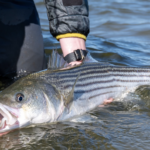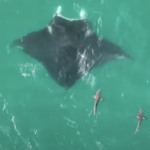
Talkin’ Striped Bass Spawn Dynamics
Consistent spawning production is paramount to a fishery’s long-term health. Many environmental factors are suspected
By Will Poston
Last week, the Mid Atlantic Fishery Management Council (Council) held its June Meeting. Several important topics were on the meeting agenda, including Marine Recreational Information Program (MRIP) estimates for 2020, updates on the Recreational Reform Initiative (more on this in upcoming blogs), and an offshore wind update. But for many of us, the big-ticket item was Tuesday’s joint meeting with the Atlantic States Marine Fisheries Commission’s (Commission) Bluefish Management Board (Board) to consider final action on the Bluefish Allocation and Rebuilding Amendment. For a refresher on what’s going on with bluefish and the need for this amendment, along with ASGA’s positions, click here.
The nearly ten-hour meeting approved final action on seven issues in the Amendment: Fishery Management Plan Goals and Objectives; Commercial/Recreational Allocations; Commercial Allocations to the States; Rebuilding Plan; Quota Transfers; Management Uncertainty; and De Minimis Provisions. Unfortunately, the Amendment’s most important measure—the rebuilding plan for the overfished stock—advanced with the least conservation-focused option.
The meeting began with Board and Council staff reviewing public comments and recommendations. The majority of comments within the recreational sector came from a form letter advocating for the 7-year constant fishing mortality rebuilding plan—the least restrictive of the three rebuilding alternatives. However, Council staff and the Fishery Management Action Team (FMAT) recommended the 5-year plan based on the Council’s risk policy, as did ASGA. Both staff and FMAT identified the 5-year plan as “the middle of the road” alternative that would satisfy both those who prefer harvest and those who value abundance/opportunity.
Two of the top recurring general comments deserve special mention—staff identified these comments as themes across all comments excluding the form letter. Twenty-two individuals and organizations contended that “management should account for the catch-and-release aspect of the fishery and recognize the value of fish left in the water.”[1] On a related note, many commenters opposed the transfer of “unused” quota between the commercial and recreational sectors, a practice that many (including us) view as potentially penalizing the recreational sector for practicing catch and release.
A Risk-Prone Rebuilding Decision
Before we dive into how each of the issues in the Amendment played out, let’s start with the task of rebuilding the bluefish stock—the most consequential issue in the Amendment. Bluefish were declared overfished in 2019. According to the Magnuson-Stevens Act, the nation’s federal fisheries law, the Council must initiate a rebuilding plan within two years and rebuild the overfished stock in a time “as short as possible” but within ten years of an overfished declaration. Because the Council and Commission jointly manage the stock, bluefish management is bound by the Magnuson-Stevens Act, meaning that a plan must be in place by the end of this year, and that bluefish must be rebuilt by 2029. Unlike the Commission, the Council has legal mandates to promote accountability and responsible management. For this reason, ASGA had high hopes for approving a rebuilding plan that would efficiently rebuild the stock.
The only rebuilding alternatives considered were a 4-year plan based on constant harvest, a 5-year plan based on the Council’s risk policy, and a 7-year plan based on constant mortality. Council staff provided their rationale for the 5-year plan in the meeting materials (see page 5):
“Council staff agrees with the FMAT that the rebuilding plan should be as short as possible while considering the needs of the fishing communities that depend on the resource. Additionally, the rebuilding plan should account for the inherent uncertainty associated with the cyclical and environmentally driven nature of the stock. Given the spread in public comments, Council staff and FMAT members noted that alternative 4c [5-year plan] may be a fair middle point that considers both the biological and social requirements as required in MSA… Moreover, alternative 4c uses the updated 2019 Council risk policy, which by design, evaluates current stock biomass in relation to its target and threshold and adjusts risk accordingly.”
Almost as soon as the Chair moved to consider a rebuilding plan, the discussion turned into a short-term harvest vs. long-term stock health debate. Nichola Meserve, a Board member from Massachusetts, offered the first motion, “to approve alternative 4d (7-year), which utilizes the constant fishing mortality rebuilding plan.” Importantly, this rebuilding plan would require that the recently updated Council risk policy be adjusted—i.e., this plan provides for a higher level of risk than the Council previously indicated it would allow. Meserve rationalized this motion by highlighting the inherent uncertainties with bluefish and the environmental factors associated with rebuilding the species.
While those concerns hold some truth, choosing the 7-year plan effectively discounted the comments contending that a quickly rebuilt stock was in the fishery’s best interest, not to mention MSA’s mandate that rebuilding be completed in a time “as short as possible” that considers the needs of fishing communities. Additionally, just because environmental factors may have contributed to the current condition of bluefish, managers should not get a “free pass” to “wait and see.” Further, FMAT, staff, and managers all pegged the 5-year plan as the balanced approach that meets the requirements of Magnuson and uses the Council’s updated risk policy.
Mike Pentony, Regional Administrator for the NOAA Fisheries’ Greater Atlantic Regional Fisheries Office and the agency’s representative on the Council and Board, made an astute comment on the 7-year approach. He said, “In order to adopt this as the rebuilding plan, the Council would have to amend the risk policy that we just adopted…We either have a risk policy that we follow, or we don’t. Changing the risk policy, or giving ourselves a pass from the risk policy, every time it gets inconvenient just seems like bad policy.” Maine Board member Megan Ware echoed Mike’s sentiment and added, “the [five-year, risk-policy-based] approach finds the best balance between [harvest/catch and managing for abundance].”
Justin Davis, a Board member from Connecticut, offered a great summary of the larger dispute at work. “From a precautionary standpoint, we can’t just assume that [environmental factors and abnormal distribution] are the lion’s share of the problem and sit back and wait for the environment and bluefish migration patterns to bail us out. We need to take appropriately conservative action. I view [the five-year, risk-policy-based approach] as the middle of the road option and has a rebuilding timeline that is appropriately short.”
The leading argument for the 7-year plan centered around “too much uncertainty” in the bluefish fishery, which “varies greatly with environmental factors.” Tom Fote, a Board member from New Jersey, said, “If I had any confidence in the figures that we have for the bluefish stocks, I’d basically do a 10-year rebuilding plan or a 7-year. But there’s no confidence in what we’re estimating.” This view is, in our eyes, problematic, to say the least. If managers are to give data limitations and environmental concerns this much weight, then a longer, more liberal rebuilding plan will just as likely leave the stock in worse shape. ASGA advocates for “better business for conservation.” In this case, that idea would have meant biting the bullet in the short term for long term stability in the health and abundance of bluefish.
Ultimately, the Council and Board approved the 7-year plan, despite the pleas for conservative yet balanced action.
Other Topics in the Amendment
With that, let’s review how the other votes played out.
Fishery Management Plan (FMP) Goals and Objectives: The Council and Board approved the proposed FMP Goals and Objectives as presented in the staff memo through consensus. The proposed goals and objectives provide a good update to the bluefish fishery and promote conservation and balance within the fishery.
Commercial/Recreational Allocation: The allocation discussion was rather difficult to follow, as several competing motions were put forward. So, for simplicity’s sake–a motion to approve status quo allocations was rejected, and a motion to update the allocations (2a-4) with no phase-in (2b-1) was approved by the Board and Council. The approved alternative allocates 86 percent of the fishery to the recreational sector and 14 percent to the commercial. Further, Alternative 2a-4 is based on historical and current conditions, an important factor considering the current poor condition of the stock, and balances the needs of the recreational and commercial sectors. Alternative 2a-4 gives the recreational sector a 5 percent allocation bump and decreases the commercial sector’s allocation by 18 percent compared to the status quo. These allocation decisions are never easy—there are always winners and losers, and it is something ASGA typically doesn’t engage in heavily given the lack of relevance to overall stock health. But the approved alternative, which was the ASGA preferred option, struck the appropriate balance between the sectors while relying on a reasonable range of historical and current information.
Commercial State Allocation: To remain consistent with our comment letter, we will not dive into this topic. In summary, however, the Board and Council approved a commercial allocation to the states based on 2009-2018 data, with review of the allocations 5 years after implementation.
Quota Transfer Provisions: The Board and Council approved alternative 5a-2 and 5b-2—bi-directional transfers with a 10 percent cap—with no objections. The general sentiment throughout this discussion was to treat bi-directional transfers as “another tool in the toolbox,” despite staff acknowledging that no transfers are expected in the short term. However, we view the practice of transfers as maximizing harvest while ignoring the widespread preference of anglers to catch and release fish.
Management Uncertainty: The Board and Council approved alternative 6b, which incorporates a management uncertainty buffer after the commercial-recreational sector split (the status quo considers such uncertainty at a fishery-wide level, prior to the split). As proponents of recreational accountability, we supported this action.
De Minimis Provision: This issue only involved the Board, so the Council was not involved in this deliberation. However, the Board rejected an attempt to grant states that contribute minimally to coastwide harvests independent management. The Board then approved the status quo alternative.
While ASGA is less than pleased with the approved rebuilding plan, we are thankful that bluefish are managed under Magnuson, because managers will be accountable to rebuild the species in seven years. Additionally, we want to thank all the managers that spoke up for conservation and responsible management, specifically Mike Pentony, Megan Ware, Kate Wilke, and Justin Davis.
You may curse them every now and then, but bluefish are a marquee species on the Atlantic coast deserving of sustainable management. Here’s to a future of scratched-up plugs, severed plastics, and frothing blitzes of yellow-eyed demons.
Have any bluefish questions or anything else relating to the June MAFMC Meeting? Drop us a line in the comments!

Consistent spawning production is paramount to a fishery’s long-term health. Many environmental factors are suspected

While the ASGA team is extremely proud of the community we’re building with the Guide

Feature Image: A false albacore being landed off Jupiter Florida by the Cheeky Fishing team,

Feature Photo: “Best Practices for Fishing Cobia Around Manta Rays” The Florida Manta Project is
We rely on our members and donations to keep fighting for a sustainable tomorrow in marine conservation.
By using this website, you agree to our use of cookies. We use cookies to provide you with a great experience and to help our website run effectively. To learn more, please review our privacy policy.
2 Responses
Thank you for the update and all the efforts by those involved, knowing and hoping that the stocks best interest is what matters. Preserving a stock while being able to fish is a delicate balance to achieve . Can you speak to angler education please regarding catch and release . Is it discussed at this level or does this responsibility lie elsewhere. Were individual state education programs suggested at all. Angler education was a major topic amongst the discussions at all the spring on line meetings i attended . Has the angler education initiative been abandoned…i sadly believe it has. After witnessing recreational anglers catching and releasing bluefish this spring , angler education is sorely needed.